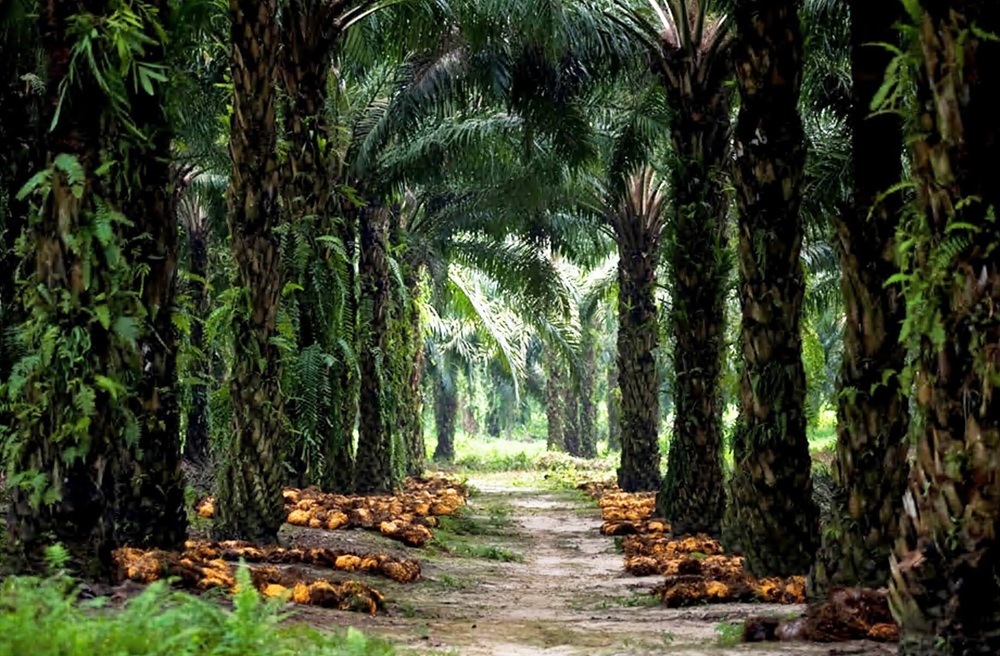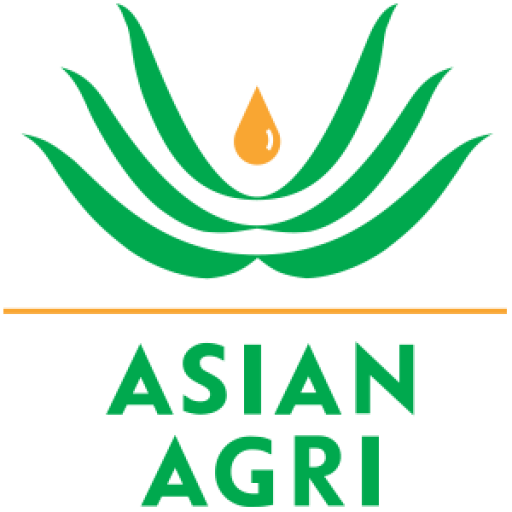Asian Agri manages about 100,000 hectares of oil palm plantations across Indonesia, and works closely with independent and plasma smallholders to produce palm oil responsibly. Our goal is to make every part of the palm oil production process more sustainable — reducing waste, cutting emissions, and creating value from materials that would otherwise go unused.
Through science, technology, and continuous innovation, we are improving how mills and estates operate by adopting a more circular approach to production. Empty fruit bunches (EFB) are composted into organic fertilizer, palm oil mill effluent is treated to produce biogas for renewable energy, and other biomass residues are recycled back into the production cycle. This circular approach helps us generate cleaner energy, reduce greenhouse gas emissions, and support a more sustainable future for local communities.
What is the circular economy?
The circular economy is a system that replaces the traditional “take-make-waste” model by keeping products, components, and materials at their highest value for as long as possible. It does this through practices such as recycling, reuse, repair, and regeneration, ensuring that resources remain in use instead of becoming waste.
Some of the key benefits of the circular economy include:
- Resource efficiency: Materials are reused or repurposed, reducing the need to extract new raw materials. For example, this can be done by recycling packaging or turning organic waste into compost.
- Lower emissions: Using renewable energy and circular practices helps cut greenhouse gas emissions. A study by the Ellen MacArthur Foundation found that applying circular principles in agriculture could reduce global emissions from the agricultural sector by nearly 50% by 2050.
- Economic opportunity: Turning waste into valuable materials encourages innovation and cost savings while supporting sustainable growth.
Community wellbeing: Cleaner production and reduced waste lead to healthier environments and stronger local communities, where people enjoy better air and water quality.

Empty Fruit Bunches (EFB) can be used as fertilizer in plantations to help prevent waste
Asian Agri’s circular economy practices
We put circular economy principles into practice at every stage of palm oil production. By finding new uses for by-products and waste, we can create value while reducing our environmental impact. The following examples show how we make this happen:
Utilizing By-Products
Our mills create several by-products, and none of them go to waste. We collect and reuse each material so it can serve a new purpose:
- Empty fruit bunches (EFB) and bunch ash are returned to plantation blocks as natural fertilizer and soil conditioner, supporting nutrient recycling.
- Palm kernel shells (PKS), taken from the hard nut inside each fruit, are exported for use as a renewable fuel in biomass power plants.
- Palm kernel expeller (PKE), the protein-rich residue left after oil extraction, is processed into nutritious animal feed.
- Decanter solids, sometimes called decanter cake, contain residual oil and volatile solids. They can be co-digested with POME to produce methane for renewable energy. It can also be dried and blended for use as animal feed.
By using every part of the fruit, we turn what could be waste into valuable resources, making our operations more sustainable.
Nutrient recycling
Palm fronds and old trunks from routine upkeep never go to waste. We lay them back on the ground as mulch, adding nutrients and helping the soil hold moisture so new palms can grow strong. Empty fruit bunches (EFB) from the mill are also brought to the fields and spread around the trees for the same reason. However, when direct application isn’t practical, EFBs are processed into bunch ash, which provides a natural source of potassium for the soil.
For liquid residues, we treat palm oil mill effluent (POME) to be returned to nearby plantations and applied as fertilizer through a flatbed system, which is a network of shallow channels or pipes that evenly distribute the treated liquid across the plantation soil. POME contains nutrients such as nitrogen, phosphorus, potassium, magnesium, and calcium, which enrich the soil and add moisture.
Following Indonesia’s environmental regulations, the treated POME must have a biochemical oxygen demand (BOD) below 5,000 mg/L and a pH between 6 and 9. Returning these nutrients to the soil creates a closed-loop system that keeps the land fertile, reduces the need for chemical fertilizers, and helps maintain a healthy ecosystem year after year.
Energy circularity
Across our mills, we capture methane from palm oil mill effluent (POME) and convert it into electricity through 11 biogas plants. Each site can produce between 1.2 and 2.2 megawatts, enough to power the mill, the kernel crushing plant, and nearby employee housing.
One of our business units, PT Indo Sepadan Jaya (PT ISJ), goes a step further by using excess methane to generate an additional 1 megawatt of clean power. This extra electricity is supplied to the PT PLN North Sumatra grid under a three-year purchase agreement, strengthening local energy reliability for communities in Rantau Prapat, North Sumatra.
We also make use of mesocarp fiber, which comes from the fleshy middle layer of the oil palm fruit contained in each fresh fruit bunch (FFB). After the fruitlets are pressed to extract crude palm oil, the remaining fibrous material is collected and used as fuel for our boilers. The boilers convert biomass into steam, which sterilizes incoming FFBs and powers other equipment, enabling us to run operations efficiently and maximize the use of every by-product.
Water efficiency
Asian Agri draws water from nearby rivers, stores it in reservoirs, and treats it on site before use. The treated water supports mill operations and employee housing, and is then cleaned again before being safely returned to the river. Because these waterways are shared with local communities, every discharge meets strict environmental standards to protect shared resources.
We also turn wastewater into value. Effluent is treated and used to generate biogas, which lowers our water footprint by reusing water within the mill instead of drawing additional freshwater, while also producing renewable energy. Through this integrated approach to water and energy recovery, we keep water use between 0.9 and 1 metric ton for every metric ton of fresh fruit bunches processed.

Asian Agri has a total of 11 biogas plants, which help cut 90% of methane emissions
Impact and outcomes
Asian Agri’s circular economy initiatives are delivering measurable results. From renewable energy to waste reduction, these highlights show how we’re making a real impact. (Note: Data are based on our 2024 Sustainability Report.)
Cleaner energy
In 2024, 96% of our total energy came from renewable sources. Most of this electricity — over 90% — powers our mills and kernel crushing plants, helping us reduce our carbon footprint while keeping operations efficient.
Less waste, more reuse
We’re making the most of by-products: 58% of empty fruit bunches (EFB) are reused, and 54% of POME is processed through methane capture facilities. Compared to 2023, solid organic waste fell by 9% and POME by 7%, meaning we’re using resources more efficiently and reducing environmental impact.
Energy from biogas
Our biogas plants capture methane from POME and turn it into electricity. Nearly 90% of this biogas is used to power our operations, supplying about 40% of our total electricity needs.
Lower emissions
With 11 biogas plants, we have cut methane emissions by almost 90 percent, preventing one of the most potent greenhouse gases from entering the atmosphere. In 2024, our Scope 1 and 2 emissions were 3.36 metric tons of carbon dioxide equivalent per metric ton of crude palm oil, a level that compares favorably with industry averages and reflects more efficient, lower-carbon operations. Our ecosystem restoration projects also capture carbon naturally, further offsetting emissions and supporting biodiversity.
Better facilities, stronger impact
We’ve upgraded 23 mills with new machinery and systems for waste oil collection and resource recovery. These improvements help us get more value from by-products and scale up circular practices across our operations.
Looking ahead: strengthening circular practices
At Asian Agri, we see the circular economy as an ongoing journey. Our focus now is on deepening circular practices across all operations to make resource use more efficient and sustainable.
Responsible waste management
We continue to ensure that all waste disposal complies with environmental regulations, protecting both surrounding ecosystems and local communities.
Smarter water use
By tracking and managing water consumption per metric ton of CPO, we aim to use water more efficiently and build stronger systems for reuse and recycling in our mills.
Better energy management
Through SCADA (Supervisory Control and Data Acquisition) systems, we can monitor energy use in real time across CPO, PK (Palm Kernel), and CPKO (Crude Palm Kernel Oil) production, helping us identify ways to improve efficiency and reduce unnecessary consumption.
Fuel efficiency improvements
We are also exploring technologies that enhance production performance while lowering energy needs, ensuring our operations continue to grow sustainably.
To see the bigger picture of how these initiatives fit into our long-term sustainability goals, explore our [Sustainability Report].
Frequently Asked Questions (FAQ)
1. What is circular economy at Asian Agri?
The circular economy at Asian Agri is a production model that keeps resources in use for as long as possible. The company reduces waste by reusing, recycling, and recovering energy from by-products of palm oil processing. This closed-loop approach lowers greenhouse gas emissions and supports long-term sustainability across plantations and mills.
2. How does Asian Agri reuse palm oil by-products?
Asian Agri gives new life to by-products such as empty fruit bunches, mesocarp fiber, and palm oil mill effluent. Empty fruit bunches are applied to the fields as organic fertilizer, enriching the soil and reducing the need for chemical inputs. Mill effluent is treated in methane-capture plants to produce biogas, turning what was once waste into a renewable energy source.
3. What renewable energy does Asian Agri generate?
Asian Agri generates renewable energy from biogas and biomass sources. Methane captured from 11 biogas plants is converted into electricity that powers mills, kernel crushing plants, and employee housing. Each plant produces between 1.2 and 2.2 megawatts (MW) of power, helping reduce reliance on fossil fuels. Biomass materials such as mesocarp fiber and palm kernel shells are also used to produce steam and electricity, further supporting cleaner, more sustainable operations.
4. How does Asian Agri reduce water use through circular economy practices?
Asian Agri treats and reuses water from mill operations and converts wastewater into biogas, lowering its overall water footprint. Industry guidance often cites about one metric ton of water per metric ton of fresh fruit bunches as a sign of efficient operations, though actual needs vary by technology and management practices.
5. What environmental impact has Asian Agri achieved with its circular economy?
Asian Agri’s network of 11 biogas plants captures methane produced at its palm oil mills from palm oil mill effluent (POME), reducing methane emissions at those mills by nearly 90%. The captured methane is used to generate electricity and steam, contributing to roughly 96% of the company’s total energy consumption coming from renewable sources such as biogas and biomass.

